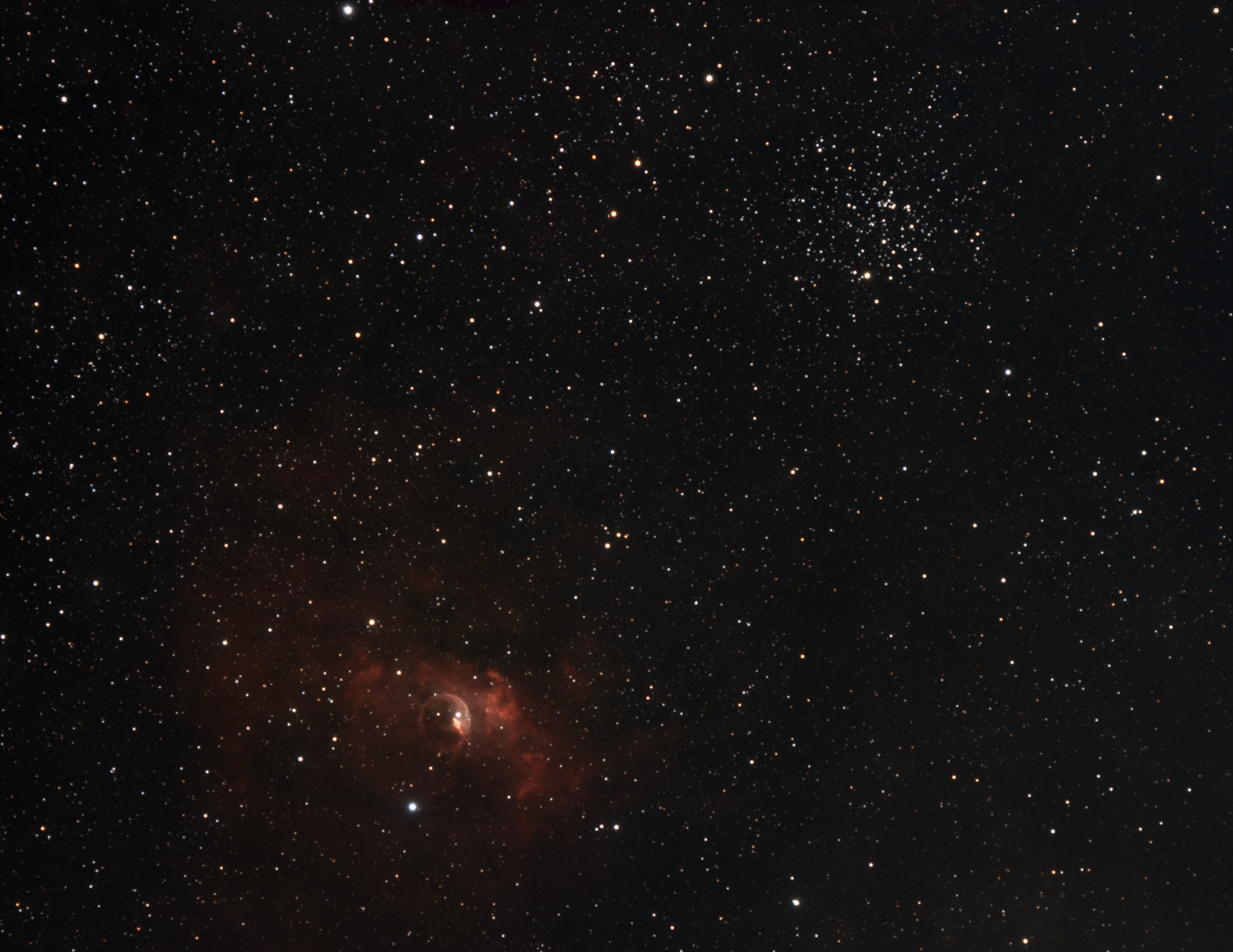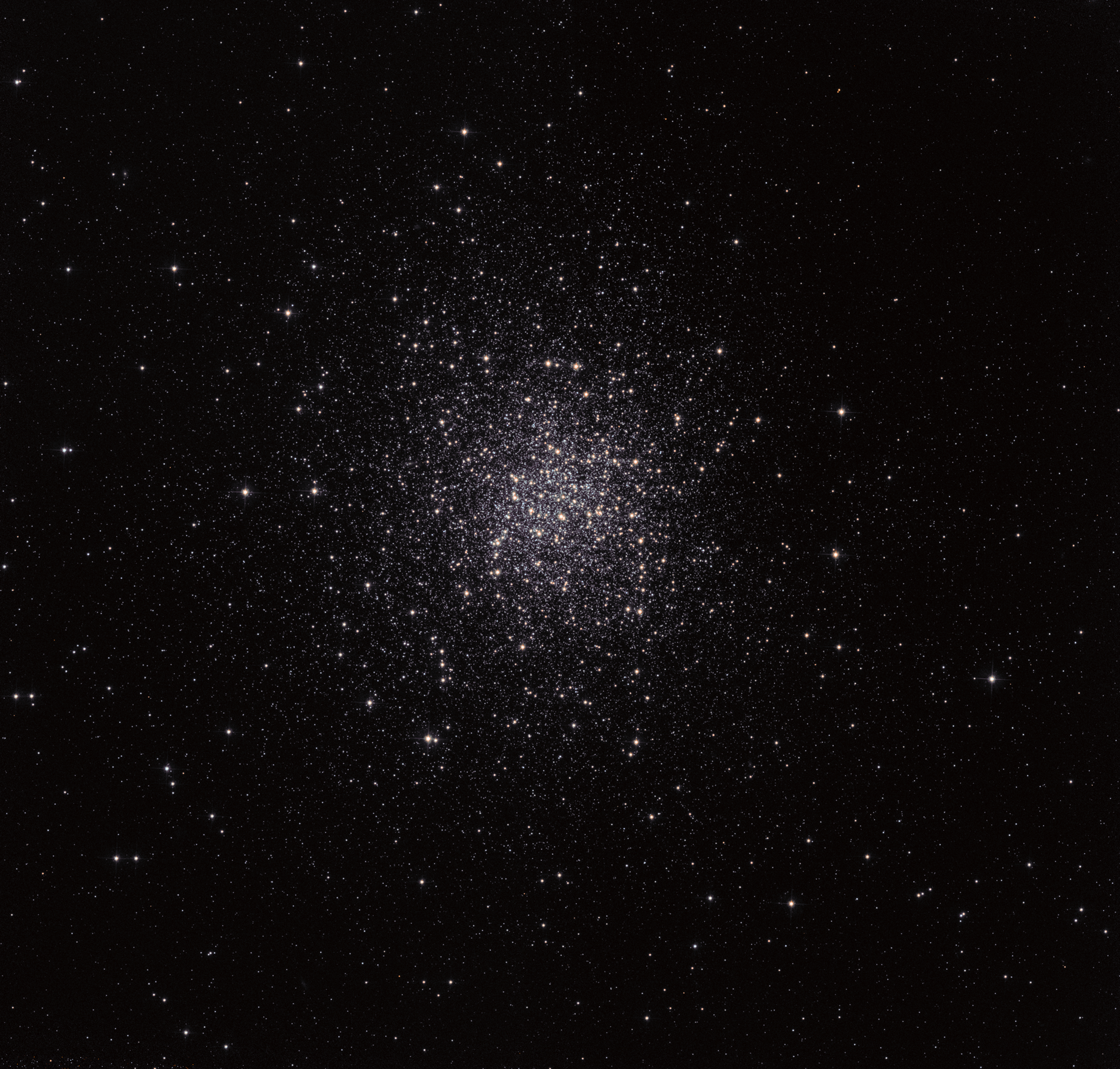December 21, 2022
IC 410 (Dec. 21. 2022, reprocess of Nov. 2020)
December 10, 2022
M20, early 2022 (re-process of May 8, 2022)
This image is constructed from data gathered by Insight Observatory's remote telescope AFIL-2, a Skyrover 130 APO located at Yunling Observatory, China. Data for this image includes 3.75 hours of exposures: 1.5 hours (18x300") through a red filter and roughly equal exposures taken through green and blue filters.
December 8, 2022
Mars & Luna Video (Dec. 8, 2022, around 3 a.m. UT)
I posted a video of what the conjunction looked like through my wonderful 6" f/8 Newtonian, just before closest approach. This little video link stays very small, though. To reach the actual posted video, click here: https://youtu.be/EoYgxrQj_YI. That will take you to the actual video posted on Youtube, which is much more like what I saw in the eyepiece.
Mars & Luna (Dec. 8, 2022, around 3 a.m. UT)
These are best 50% of a couple of 300-frame SER videos made with the QHY 5iii485c camera through my wonderful 6" f/8 Newtonian with Spooner-finished mirror. The light from Mars took 4.57 minutes to go from Mars to Earth and the light from the Moon took 1.32 seconds. Moon, 395300 km; Mars, 82.2 million km. So by the time I took this picture, Mars had moved.
Below is a single frame, perhaps the best of the night.
November 9, 2022
October 29, 2022
Bubble Nebula and M59 (Oct. 2022)
This is 26x1200" with the Atik 460EXC through a SW 80ED at f/6.375, with the SW 80ED reducer/flattener. I have always been impressed with the optics on this scope. On this image, I had to balance the stars over the nebula against the stars in the cluster. I wanted to show the cluster well but not overwhelm the nebula.
October 22, 2022
NGC 7380, a bowl around DH Cephei (Sept. 2022)
This is 34x1200" with the Atik 460EXC through the 203mm Synta-ONTC Newtonian at f/4.95, an Astronomik CLS filter, and the Baader MPCC Mark II.
October 13, 2022
M39 (Oct. 2022)
This is 13x360" with the Atik 460EXC through a Sky-Watcher ED80, SW 0.85x reducer/flattener, and Hutech IDAS-LPS-P2 filter.
October 10, 2022
NGC 7789 (Caroline's Rose), Oct. 2022
This is 12x360" with the Atik 460EXC through a Sky-Watcher ED80, SW 0.85x reducer/flattener, and Hutech IDAS-LPS-P2 filter. The cluster was discovered by Caroline Herschel in 1783.
September 30, 2022
September 14, 2022
Butterfly Wing Nebula, part of IC 1318 (August 2022)
This portion of the Gamma Cygni Nebula, IC 1318, is half of what is often called the Butterfly Nebula, which does sort look like a butterfly from 4,000 light years away.
The star at the center is HD194789, a blue-white B6 subgiant only 1066 light years away. The bright star upper right is HD 194558, a K2 subgiant only 658 light years away. These stars are thousands of light years in front of the nebula. They give a sense of the depth of a view through the telescope.
The image is 11x1200" with the Atik 460EXC through an Astronomik CLS filter and the 203mm Synta-ONTC Newtonian at f/4.95.
September 11, 2022
NGC 6781 (July 24-25, 2022)
NGC 6781 is a wonderful planetary nebula in Aquila. This image is 10x900" with the Atik 460EXC through the 203mm Synta-ONTC Newtonian at f/4.9 and an Astronomik CLS filter. This one was three years on the list. I've tried and failed to see it visually several times with my wonderful 6" f/8 Newtonian.
August 27, 2022
M15 (July 2022)
M15 is one of our oldest globular clusters. It has over 100,000 stars. Because it is only 35,700 light years away, it is bright. I can see many individual stars in the cluster with my 6" telescope from my backyard. M15's core is densely packed; even the image seems to show the cluster growing denser toward the center of the cluster, though that's a little deceptive as M15 is 175 light years across! I doubt my little image would show true density (relative to other clusters) from this far away. Anyway, this is just 8x180" with the Atik 460 EXC through the 203mm Synta ONTC Newtonian at f/4.9 and an Astronomik CLS filter.
August 18, 2022
NGC 6888, the Crescent Nebula (July 2022)
This is not my first Crescent, but I wanted to see what I could get with an OSC and light pollution filter. This is 15x1200" with the Atik 460EXC, Synta ONTC 203mm Newtonian at f/4.9, and the Astronomik CLS filter.
July 13, 2022
NGC 6791 (July 9, 2022, UT)
This star cluster is one of the oldest open clusters in our sky, perhaps 8 billion years old, and lies around 13,300 light years away. Estimates gives it a mass equal to 10,000 suns, and educated guesses suggest that at formation its mass was 10x greater. A color-magnitude diagram included in the study linked below suggests that the cluster's stars are magnitude 14 and dimmer. My image captures stars down to around mag. 19, but the cluster contains thousands more stars dimmer than that.
See https://iopscience.iop.org/article/10.3847/1538-4357/aae4e5/pdf.
The red star to the upper right of the cluster is U Lyrae, a carbon star.
This image is 15x1200" with the 203mm Synta ONTC Newtonian at f/4.95, Atik 460 EXC, and Astronomik CLS filter.
June 8, 2022
M57 in 1200" subs (May 2022)
Here is M57 with 1200" subs. Through an Astronomik CLS filter from my site, 1200" subs put the nebula itself at 75% to the right on the histogram. Much more exposure would have started whiting out the primary target. Anyway, M57 is a lot of fun. You can see in this image a hint of the expanded shell if your monitor is set to show relatively dim things. This is 12x1200" through the 203mm Synta ONTC Newtonian at f/4.9 and an Astronomik CLS filter with the Atik 460EXC camera.
M101 in 9x1800" (May 2022)
I decided to try 1800" subs on this dim galaxy in Ursa Major. I've only seen it visually a couple of times, and it doesn't look like this in my relatively small scopes! This is 9x1800" through the 203mm Synta ONTC Newtonian at f/4.9 and an Astronomik CLS filter with the Atik 460EXC camera. Might be fun to go back next year and gather more data. This image benefited from Noise Exterminator.
June 4, 2022
NGC 4490 & 4485 (April 2022)
This image is 16x900" with the Atik 460EXC through the 203mm Synta-ONTC Newtonian and Baader MPCC Mk II at f/4.9.
June 1, 2022
NGC 1955, 1968, and 1974 (aka NGC 1991) (2018)
 This data was gathered by Martin Pugh in Australia in 2018. (I've taken my time with it.) The scope was a 12" RCOS in an observatory in New South Wales. It is 12 hours of Ha and O3, combined. The NGC numbers refer to three clusters of stars beginning lower left and proceeding up and to the right, mixed in with three clumps of nebulosity.
This data was gathered by Martin Pugh in Australia in 2018. (I've taken my time with it.) The scope was a 12" RCOS in an observatory in New South Wales. It is 12 hours of Ha and O3, combined. The NGC numbers refer to three clusters of stars beginning lower left and proceeding up and to the right, mixed in with three clumps of nebulosity.M105, NGC 3384, NGC 3389 (Mar. 2021)
May 21, 2022
Lunar Eclipse - Just Post-Mid-Eclipse (May 15, 2022)
May 20, 2022
May 17, 2022
Lunar Eclipse, First Image (May 15, 2022 CDT)
May 11, 2022
Rupes Recta (the Straight Wall) to Mare Nectaris (Sea of Nectar) (May 10, 2022)
The moon is a busy place! The Straight Wall is a prominent feature (upper left), but one could easily get lost exploring from there to the Sea of Nectar.
This is a stack of about 200 frames gathered through my wonderful 6" f/8 telescope with a Vernonscope 1.5x barlow, so effectively at f/12, with the QHY 5iii485c camera.
May 8, 2022
M20, from Insight Observatory's ATEO AFIL-2 (Mar. 2022)
This image is constructed from data gathered by Insight Observatory's remote telescope AFIL-2, a Skyrover 130 APO located at Yunling Observatory, China. Data for this image includes 3.75 hours of exposures: 1.5 hours (18x300") through a red filter and roughly equal exposures taken through green and blue filters.
April 30, 2022
Eastern Veil Nebula, NGC 6992 (Deep Sky West Data, 4-2022)
April 22, 2022
NGC 6193 & 6188 in Ara; Data from Deep Sky West
April 9, 2022
IC348, M76, M67, M106 (2020-2022)
These are images I took over the last 18 months that I never posted. I could never get them to look just right and so never posted them. But this is a blog, not a gallery. These are my observations as I have them. I don't post everything, but here are some things I did and want to remember.
Each image was taken with the 203mm Synta-ONTC Newtonion and Atik 460EXC.
January 15, 2022
Palomar 2 & Pal 2 with the Hubble (Jan. 2022)
Palomar 2 is 34 kiloparsecs from the galactic center, one of the most far-flung globular clusters. That makes it about 26 kpc (+-4) from us (about 85,000 light years). That is why Pal 2 looks so small.
Another obstacle makes Pal 2 hard to study: the cluster sits behind a cloud of dust, and the cloud is not uniform but covers different parts of the cluster differently. The cloud makes it hard to obtain reliable star magnitudes. A 2020 study (Bonatto & Chies-Santos) says the cloud "leads to severe photometric scattering related to differential reddening." 2689. But the study heroically sorts through Hubble data to reach an informed estimate of the cluster's distance. (The study also gives the best current color-magnitude diagram for Pal 2.)
The same study at 2693 posits that Pal 2 contains 140,000 stars. Too bad it's so far away. It would be stunning to see it close up.
This image is 21x900" with the Atik 460EXC through the 203mm Synta ONTC Newtonian at f/4.9 using an Astronomik CLS filter.
But---there is Hubble data, as the study says, so I went to Hubble's Legacy Archives and fetched it. It was taken in deep red and broadband, so the colors below are just a good guess. Once I had the Hubble data, I figured, hey, why not add it to my image? So here first is my image with the Hubble data added in---my collaboration with the Hubble on Pal 2. You can see the stars are a lot brighter. I can reach mag 20 from my backyard in one night, but the Hubble data goes down to mag 25 or so. Adding this to my data makes the cluster a lot brighter, though shrinking the Hubble scale to fit my images more or less means that that data shows only the brighter stars and clumps, so the Hubble data does not really add stars to my data as much as it makes everything brighter.
And here is my version of the Hubble data from the Hubble Legacy Archives:



































